Basic Data
Customers
For further description, see the Suppliers/Customers chapter.
Articles
For further description, see the Articles chapter.
Price Lists
To be able to use Price Lists, you need to run the function Configure Price List, which is available in the tree menu Sale / Processing of Sales Orders / Basic Data / Price Lists, and to check the field called Apply New Price Lists.
At the same time, you need to define the books in the Books of Price Lists function. The function may also be activated from the tree menu Basic data/Books of Price Lists.
It is also necessary to set the particular rights on the 5th page in the Users - Set Rights book, if you want to work with the Price Lists book.
Price List Settings
Price List Settings form runs from the tree menu Sale/Basic Data/Price List Settings.

Pict.: Price List Settings code list
It is necessary to have the Use New Price List field checked if you want to use new price lists in business transaction. If this field is not checked, you can work in the Price Lists book (to insert new price lists, to edit the existed ones), but the prices will be added according to the original pricing.
If the flag Prices by Date of Issue is checked, the prices will not be considered by the current date, but by the date of issue from the Sales Order in the case that it will concern a Sales Order or a subordinate document, or eventually the date of issue from the free document will be applied.
If the flag Prefer Prices from Other Price List Items is checked and the articles are defined in the price list of the Other Price List Items table and there are one or more simultaneously existing other price lists derived from this price list, the price from the Other Price List Items section will be set into the business transaction even though a lower price might be found in the derived price lists.
This category is accessible as a new field on the Article card in the Sale folder in the bottom part of the table if you check the Use field (Notice: available only in the new user interface). You can define particular records for that category in this field. At the same, time you can choose the category in the Definition of Price Calculation (Definition folder, upper part) in the price list.
Price lists can be defined for particular Article cards, product groups, and product keys. You can create a new price list from an already existing price list, but you can also define your own Article Categories for price lists. Clicking ![]() button from the Price Lists folder tab, we may recalculate the price lists only for the given Article card.
button from the Price Lists folder tab, we may recalculate the price lists only for the given Article card.
Books of Price Lists
You can insert Price lists into particular books. The books can be set in the Administration of Books function, or you can run the Book of Price Lists function from the tree menu Basic Data / Books of Price Lists or Sale / Processing of Sales Orders / Basic Data / Price Lists. Switching between individual books is usually executed by Alt+F10 keys.
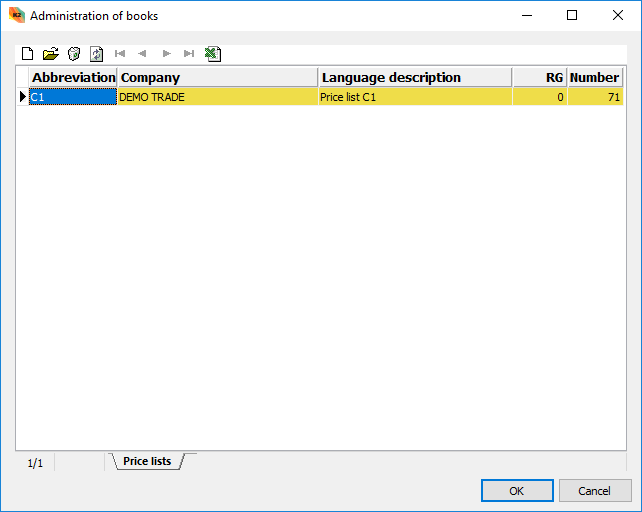
Picture: Administration of Books of Price Lists
It is necessary to enter the abbreviation if you insert a new book (via the Ins key).
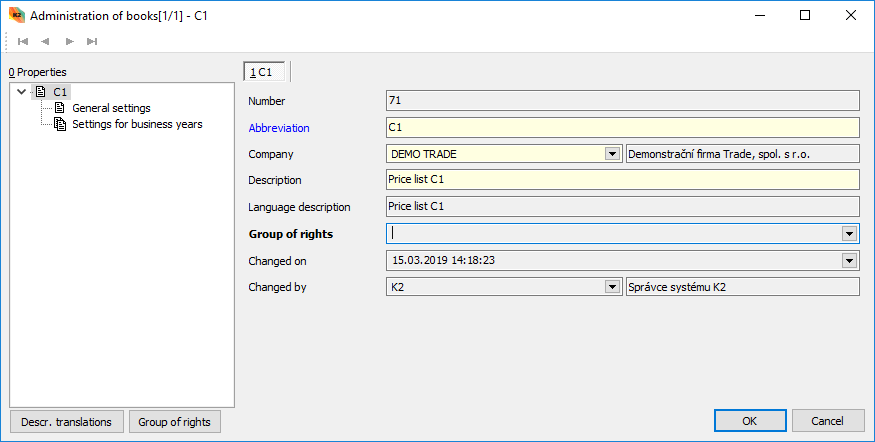
Picture: Books of Price Lists
Field description:
Abbreviation |
Used to sign given books. |
Company |
Client company. |
Description |
Description of a Price List book. |
Language Description |
Potential language description of a book of Price Lists. Language descriptions can be defined by the Description Translations button. |
Group of Rights |
Particular books of Price Lists can be accessible only to users who have the particular group of right defined. You can add the group of rights by the Gr. of Rights button. |
Changed |
The date and time of the last change is added automatically. |
Changed By |
The user is added automatically as well. |
You can define the language translation of the book via the Description Translations button. It is displayed in the Language Description field.
You can set the group of rights for a particular book by means of the Gr. of Rights button. Information will be displayed in the Group of Rights field.

Picture: Books of Price Lists - Default Settings
Field description:
Price List Priority |
The higher the number, the greater priority of the price list. If two price lists for applying a price are found, the one with the lower price will be selected by default. However, if the situation occurs where a price list with the higher price should be applied for specific customers, this can be set via the price list priority. Such price list will be set with a higher priority. When a price list is being created, the priority field will be entered to the price list document. |
Price List Currency |
When a price list is being created, the Currency field will be filled in with this value. |
If the option Set Price List as Active While Confirming is checked, the option Active will be set on the price list document during the confirmation.
If the option Set Price List as Inactive While Confirming is checked, the option Active will be deactivated on the price list document during the cancellation of confirmation.
You can set the business year and numbering of documents in the Settings for Business Year tab.
Price Lists
The Price Lists module keeps the records of individual price lists. Switching between individual books is usually done with the Alt+F10 keys. The marked price lists may be recalculated via the function Bulk Actions - Recalculation.
The condition (except for the active option Use new price lists in Price list settings) for the use of the price list document in sale must have the price list confirmed and the Active field checked on the Basic data tab. The field may be checked with the F7 key on the current record.
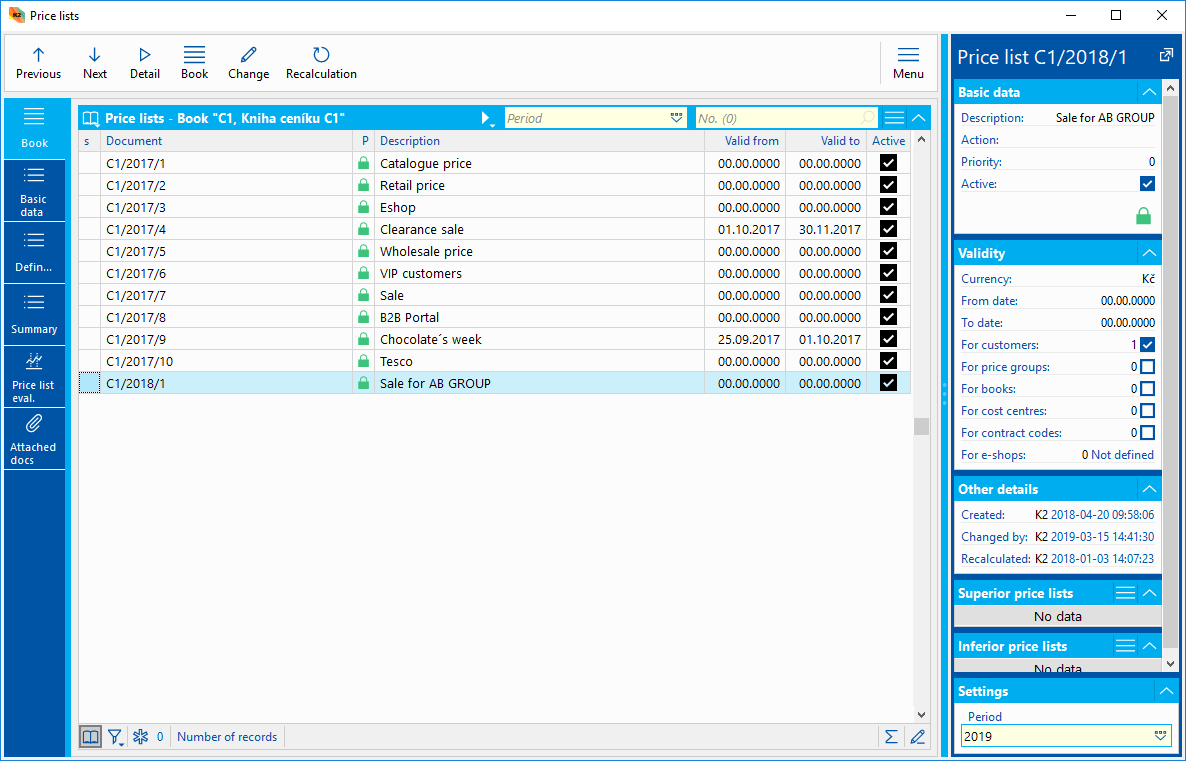
Picture: Price Lists - Book (List folder)
This page defines the price list attributes. The obligatory field is Apply the currency on docs. You can choose the way of applying currency to the selected currency (the currency of your own company is predefined):
- Any Currency - the price list refers to the selected currency,
- The Same Currency - the price list refers only to the document which is to be issued for the same currency as is the value in the Currency field in the price list,
- The Same or Own Currency - the price list will be applied to the document which is to be issued for the selected currency or the currency of your own company.
Other information is compulsory and shows details of the price list. You can set the validity interval of price list, select the particular suppliers who relate to the price list, or define the price groups. A price list can be set only for the particular books of Sale, or only particular cost centres may be selected. By checking the field Direct Price Entering, we can set whether we will allow to enter a price directly from an Article card. To be able to actively use a price list on Sale documents (except for the confirmation of a price list), the user must check the Active field (manually or by pressing F7 in the case of a previously confirmed document).
You can add comments to a specific price list, or use the folders as a header or footer text.
If there are more price lists found during inserting the articles to a Sale document, the price list with the lower price takes priority over the others. This can be changed by setting a priority. If a price list is set with a higher priority, the price from this price list will be applied even though this price would be higher than the others. The priority field is in the Preview, where it cannot be changed. To be able to change it, you must add the field to your columns. If the field is in the columns and manual editing is enabled, you may manually edit the value. Its value is set according to the settings in book of Price Lists by default.
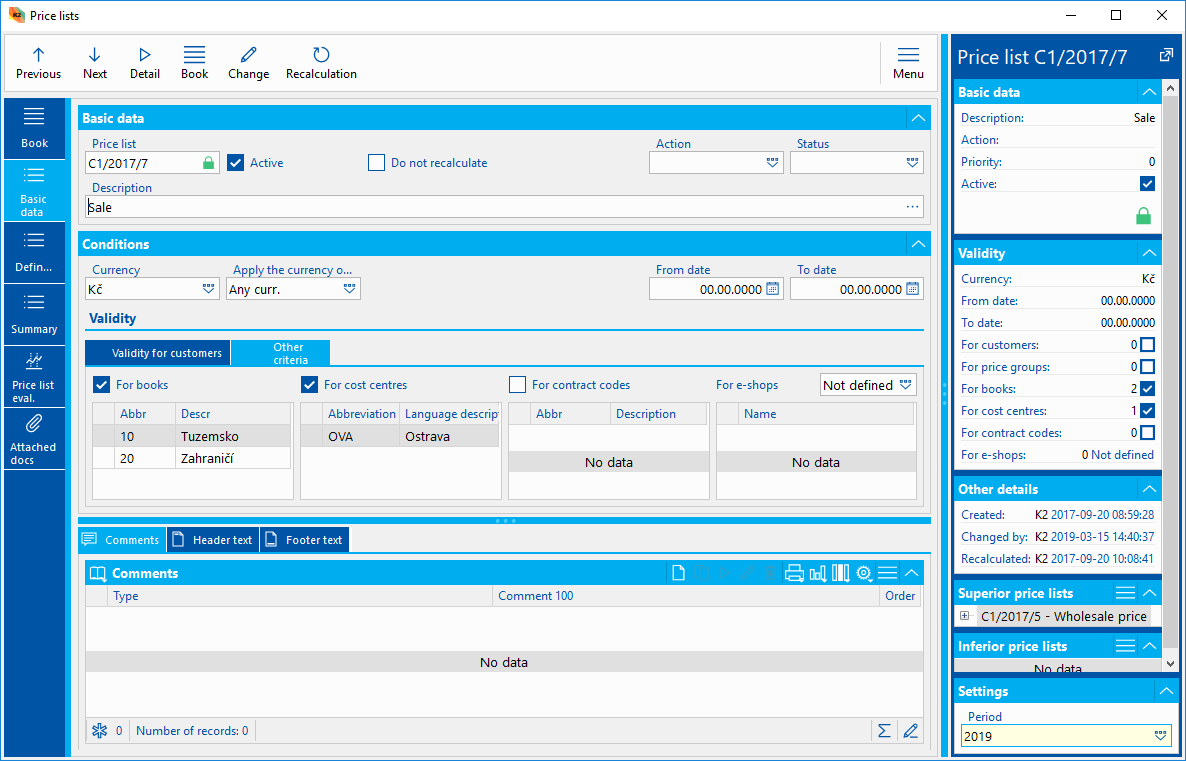
Pict.: Price Lists - Basic Data page

Pict.: List - Priority Column page
You can define the items of price lists on a card called Definition. An Article card can be the source of items for a price list. You can also use product groups, product keys, user-defined categories, or an already existing price list as a source. The list of articles from this source is displayed for that source from the second part of Definition card. A user-defined category will appear in the list if these categories in Price List Settings have the Use flag.
If some articles are contained in various sources repeatedly, the lowest price will be applied either for the amount or for the unit in the document.
It is possible to set the source of the original price for each price list source mentioned above, and, depending on the source of the price, also additional data (rounding, amount, unit).
In the second part of Definition Items is a list of all article cards, which belong to the above-selected product key, product group, category, or price list. If you go through the items in the Price Lists - Definition of Price Calculation part, the list will be updated in this part.
The Other Price List Items part defines the definition of Article cards for a particular price list, whose price is not derived from e.g. margin. It is thus used to set fixed prices and quantities. If a price list has the Direct Price Entering flag checked, it is possible to set the price of this price list directly from an Article card. A price entered this way will then display in this table.
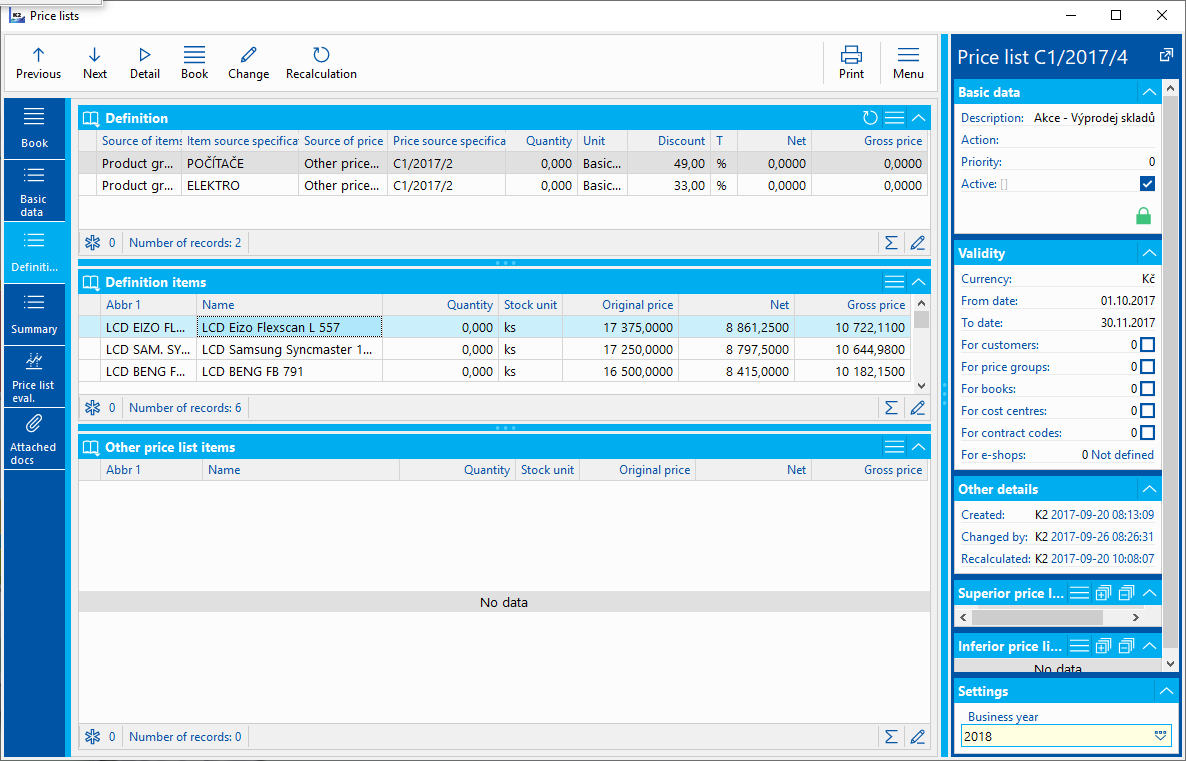
Pict.: Definition card
The Price Lists - Definition of Price Calculationform will be displayed after you press Ins.
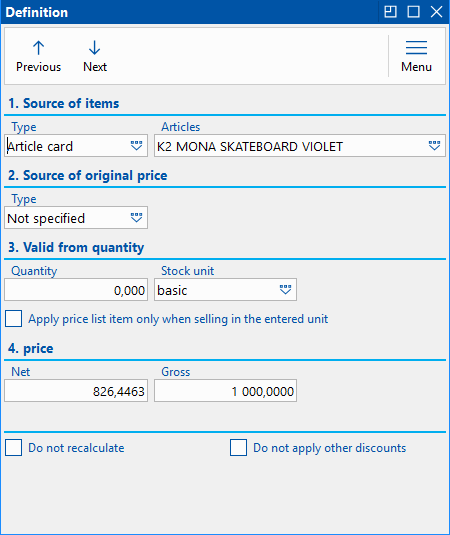
Picture: Price Lists - Definition form
You can select the source type in the Items Source section:
- Other Price List - after you select this option, the Price List field will be displayed and you can select an already existing price list. If we define a price list in currency, it is possible to define in the Exchange rate field the value of the exchange rate according to which the prices will be calculated. This rate is not a rate from the exchange rate list and has no connection to the exchange rate list. The field is accessible if the price list currency is different from the source price list currency. If the value remains zero, then the prices are recalculated according to the current exchange rate.
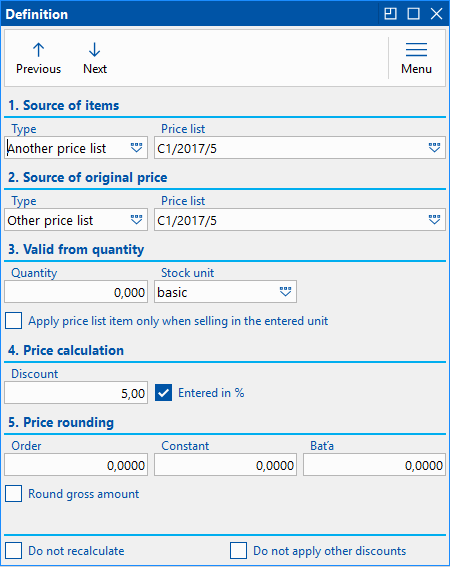
Picture: The form with the option Other Price List
- Article card - if you select this option, the Article field will be displayed, and you can select a card.

Picture: Form with the option Article card
- Product Group - if you select this possibility, the Product Group field will be displayed and you can select the product group.
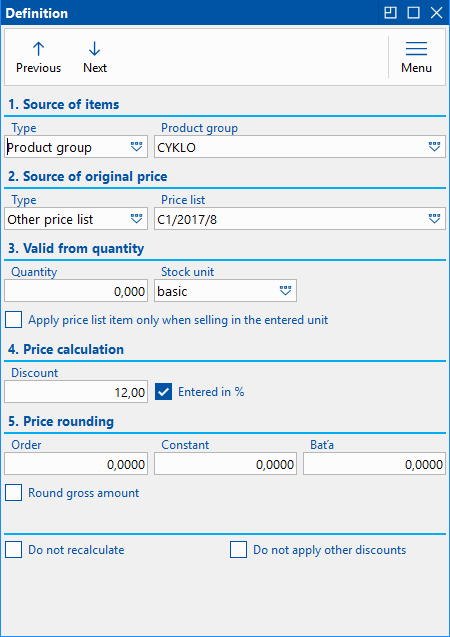
Picture: Form with Product Group selection
- Product key - if you select this possibility, the Product key field will be displayed and you can select the product key.
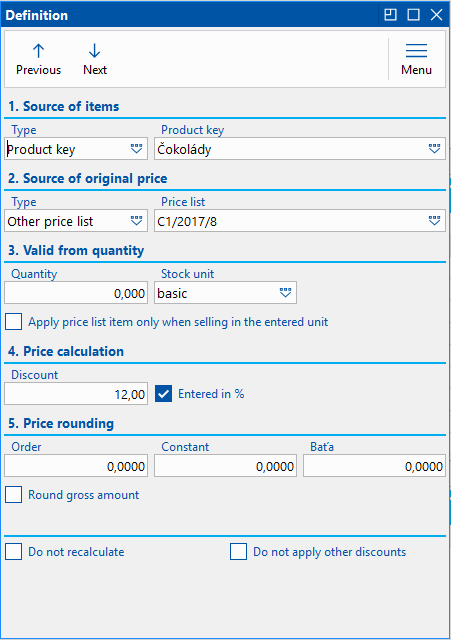
Picture: Form with the option Product Key
If a category is defined in the Price List Settings and the flag Use is checked, these categories will also be displayed as an option for further choice.
In the Original Price Source section, you can select:
- Other Price List - after you select this option, the Price List field will be displayed and you can select an already existing price list document. The Rounding section will be accessible at the same time, and you can define how to round the amounts.
- Catalogue Price - after you select this option, the catalogue (basic, selling) price will be the initial price. This field (Selling Price) is available in the Article book on the Sale card in the new user interface.
- Margin - if you select this possibility, the Margin field will be displayed, and you can select margins according to which the prices will be derived. The Rounding part will be accessible as well.
- Not entered - the price will be derived from the values entered in Dependency on Quantity and Price.
In the Dependency part, you can define for what quantity and unit of measure the price should be defined. If the Apply Price List Item Only When Selling in the Set Unit flag is checked, the price will be applied only if the unit of measure from the Unit field in the document is selected.
You can set a discount in the Price Calculation section. Positive number means discount, negative one would mean surcharge. If you check the Entered in % flag, you will define if you deal with a surcharge in percentage or an absolute amount.
Set the way of rounding in the price rounding section.
Displays the list of definition items from the Price Lists - Definition of Price Calculation part. If you go through the items from Price lists - definition of price calculation part, then items of this definition will be displayed in Definition items part.
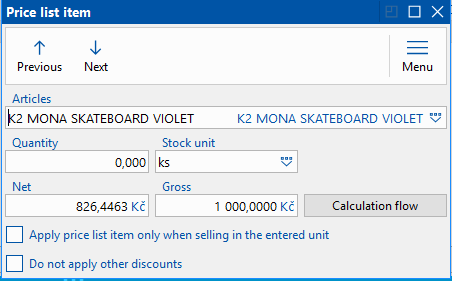
Picture: Definition Item
You can use the last part of Other Definition Items if you enter fixed prices and the amount of Article cards. The Price List Item form opens after pressing the Ins key. Select an Article card, and optionally add an amount, a unit and a Net and Gross price. If you want to apply this for a particular unit of measure, just check the Apply Price List When Selling in the Set Unit flag. In this case, the discount will be applied only if the unit of measure is selected on the Sale document.
The Other Price List Items part defines the definition of Article cards for a particular price list, whose price is not derived from e.g. margin. It means that it enters fixed prices and amounts.
A Summary card displays the list of articles from a price list in the upper part. If one Article card is in the price list more than once, a record with the lowest price will be displayed in the summary.
In the lower part, there is a list of all customers that the price list relates to. If the conditions for customers or price list groups are not on the Basic Data card (price list applies to all of them), the list of all customers on the Summary card is not displayed.
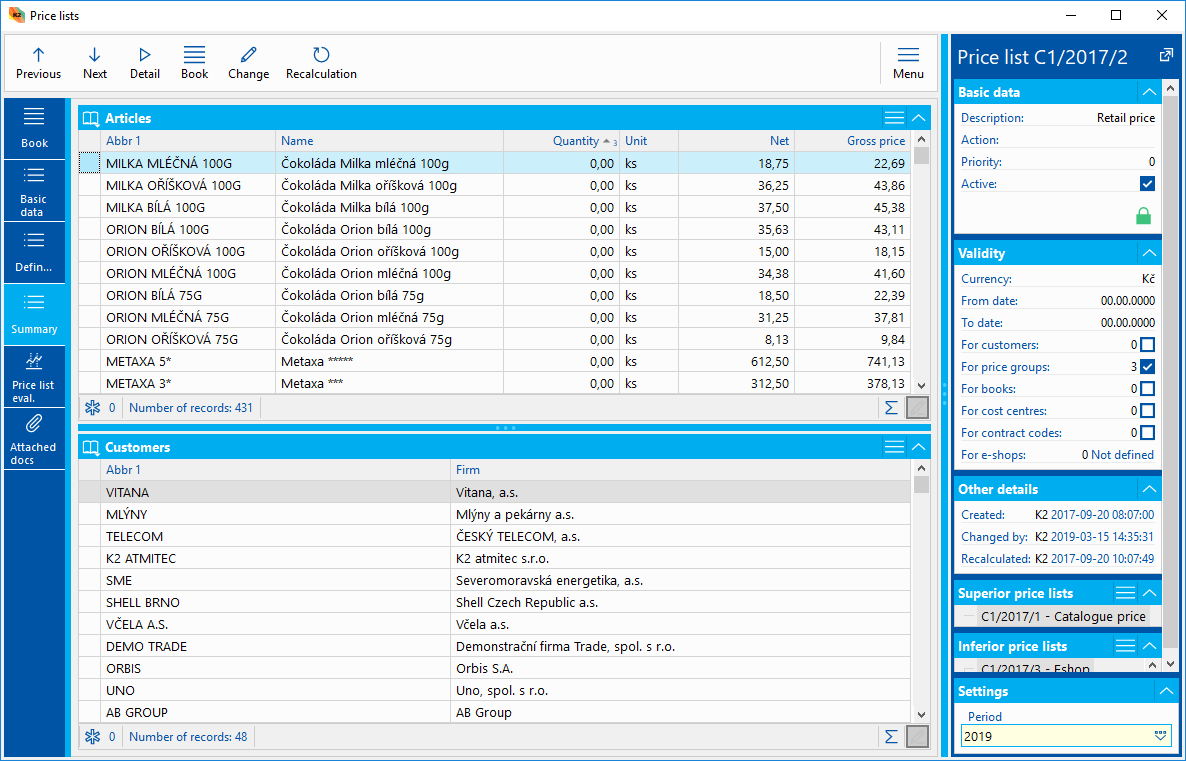
Picture: Summary card
The card displays an overview of Sale items, where the price from the applied price list is stated.

Picture: Sale Items card
A card where you can add document and ext. documents
The recalculation may be run over one price list (the Recalculate button in the user menu) or for several selected price lists. More price lists at once may be recalculated via the function Bulk Actions - Recalculation.
After running the script, a window with two options will appear:
Recalculate All Subordinate Price Lists and Recalculate All Superior Price Lists. If checked, an automatic search for, an arrangement of, and a subsequent recalculation of all subordinate/superior price lists will occur.

Picture: Dialogue for Price List Recalculation
If the user chooses to Recalculate by Article Container (the option Menu / Recalculate By Article Container), the prices of only those articles in the container in the Article module will be recalculated.
The function may be activated with F7 in the current record. The function will set/cancel the checking of the Active field in the Basic Data folder tab. The condition is to have the Confirm Price Lists user right (after the setting) and Cancel Confirmation of Price List (after cancelling the flag).
You may also recalculate price lists via the Task Scheduler. After pressing the Ins key in the Other / Recalculation folder in the Batch Items section, the option Price List Recalculation becomes available.
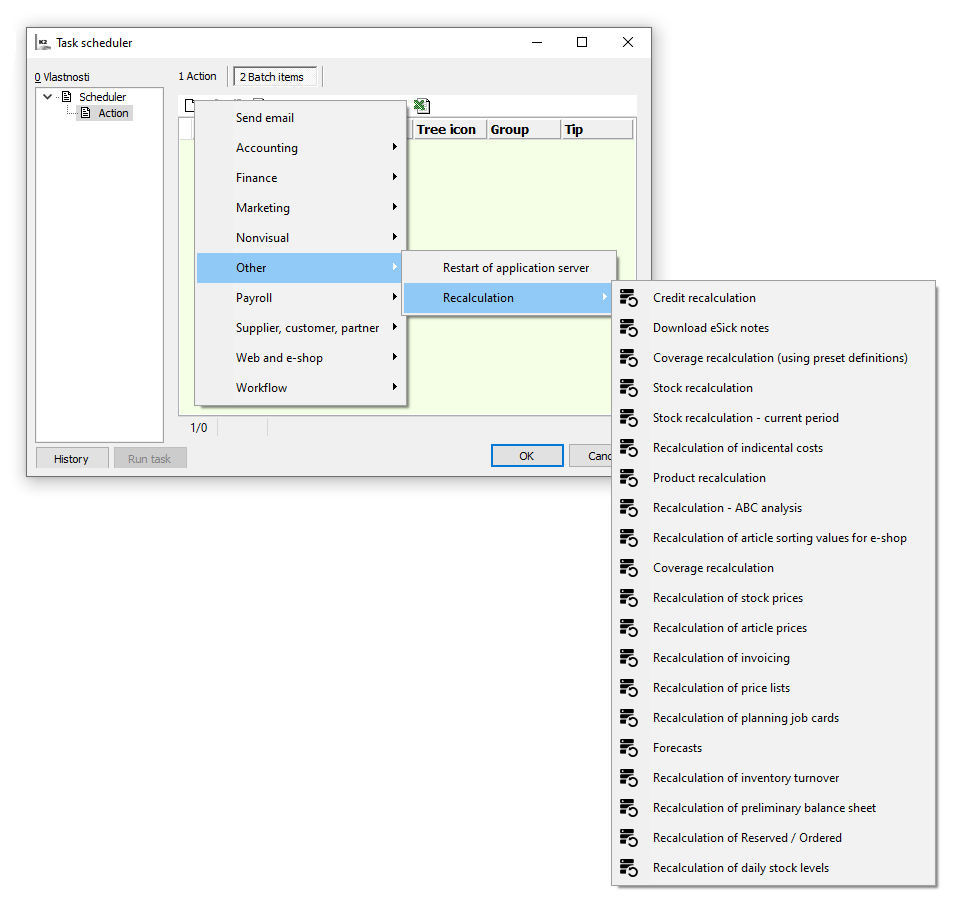
Picture: Inserting Price List Recalculation into the Task Scheduler
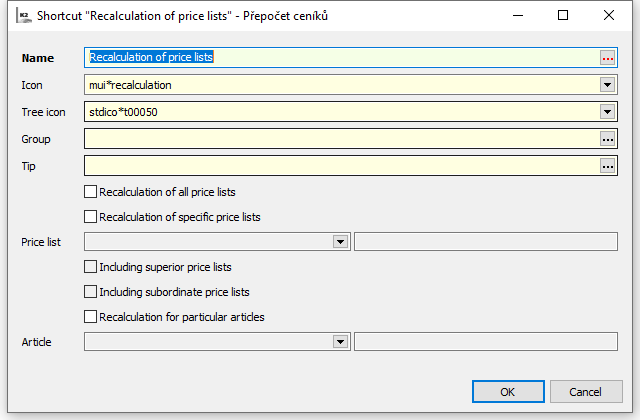
Picture: Task Scheduler - Price List Recalculation
You can set the price list recalculation in three ways:
- Recalculate All Price Lists - if checked, all price lists will be recalculated
- Recalculate Specific Price List - if you choose this option, you need to specify whether also the superior and subordinate price lists should be recalculated. The recalculation does not concern other price lists.
- Recalculate Specific Articles - articles will be selected from the book. A recalculation of the given price lists which contain the articles will follow. Note: The date and time of recalculation of a given price list will not manifest in the Recalculated By field in the price list document Preview.
In the Own company field, we can define our own company for which the recalculation is to be started. If the field is empty, the recalculation is started for all own companies to which the user who starts the recalculation using the task scheduler has the rights.
Data for Price Lists in the Book of Customers and Sale Documents (New User Interface)
There are new fields - Price List and Special Offer - which are related to the new price making. They may be found in the Customer code list on a Sale card, and in the Sale documents on the Items card. These fields are accessible only in the new user interface.
On the Customers tab, there is a Define price groups button, which allows you to set a different price group in the Change state for the selected product group than in the Price group field and thus ensure that the price for articles from the product group is obtained according to the price group defined here. take precedence over the price group defined in the Price group field. After pressing the button, the form Price group for the customer will be displayed. Press the Ins key to display a list of product groups. Press the Enter key to confirm the selection and a list of price groups will be displayed. Again, confirm the selection of the price group with the Enter key. A record with the product and price group will be added in the definition of price groups. By line editing we can also set a discount for this combination. The amount of the discount will be reflected in the Discount field on the sales receipt.
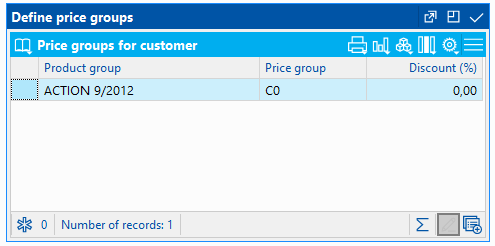
Picture: Form Definition of price groups
Price list - if the Price List field is entered in Sale documents, the prices in documents will be preferably taken from this price list; otherwise a selling price will be added from articles (the Selling Price field in the Articles code list on a Sale card). If you enter this field in Customers, the Sale document can be issued for a particular customer, and the prices on items will be added from the price list selected in the Price List field in Customers.
Special Offer - if a Special Offer is entered, only the price lists which have this offer will be taken into consideration.
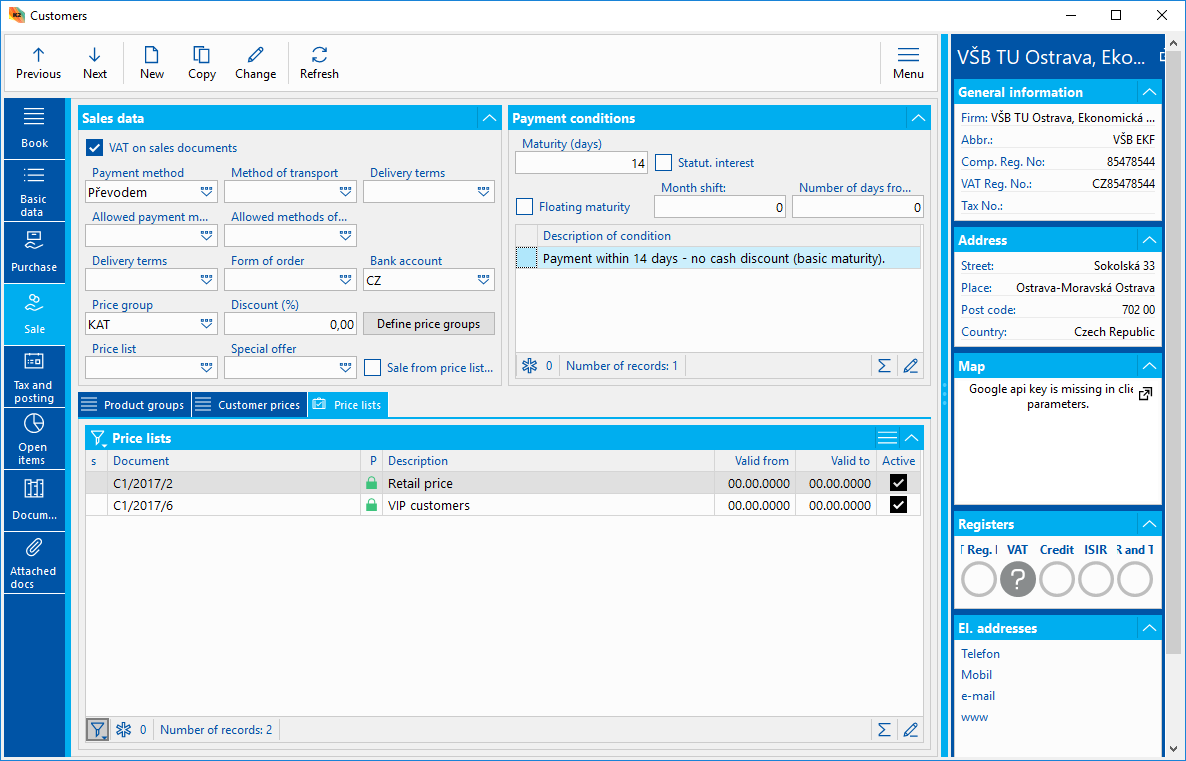
Picture: The Price List field and a Special Offer on a Sale card in Customers

Picture: The Price List field and a Special Offer on an Items card
Article - Price list
The list of price lists in which the article card is available on the Sales tab and the Sales prices sub-tab. By default, all price lists are displayed. If it is desired to see only active price lists, then this can be achieved by pressing the Show only active price lists icon. Price lists that do not have the Active flag set will not be displayed in this case.
If the articles are on an already canceled price list, then these price lists will not appear in this list by default. If the Show inactive records user right is checked, then these canceled records will also be displayed
If the price list has the Direct Price Entering flag checked, you may insert the price for the chosen price list directly on an Article card. You may manually edit the Net, Gross or Quantity columns and set a price and quantity for the selected price list on the Sale tab in the bottom table Price Lists - Direct Price Entering. A record with the price and quantity will be inserted into the Other Price List Items section of the selected price list. Should the edited price list have its own subordinate price lists, a query asking whether you wish to recalculate the subordinate price lists as well will appear.
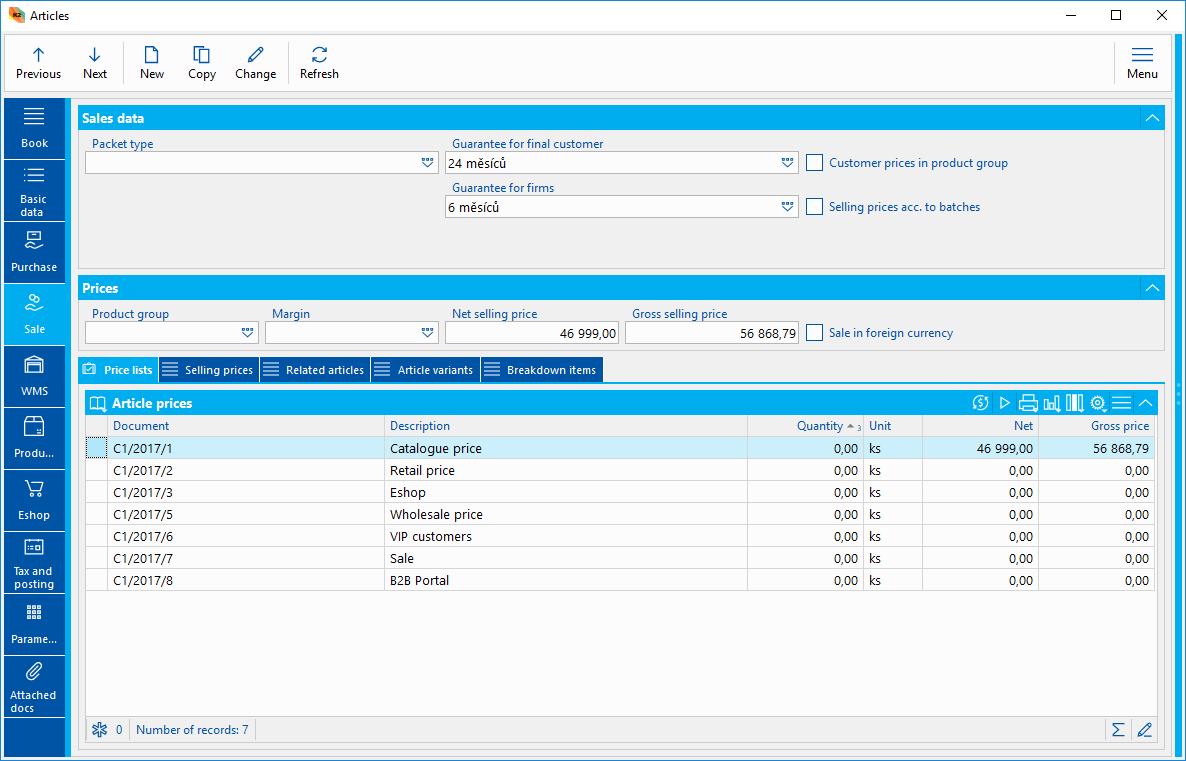
Picture: Article Card - Sales price tab